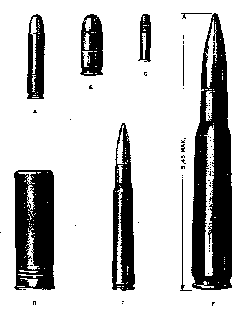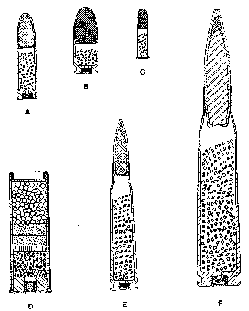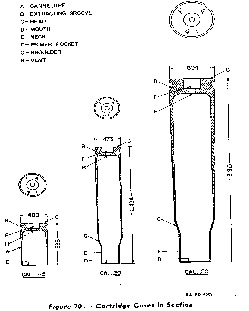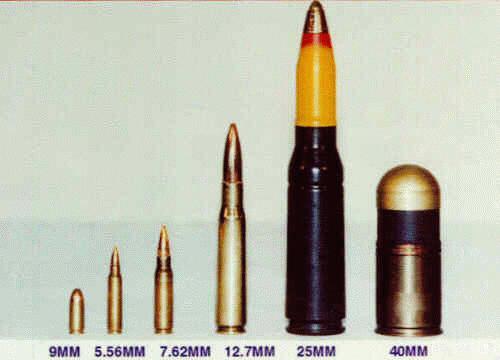Pistol - A pistol is a hand-operated firearm having a chamber integral with or permanently aligned with the bore. Revolver - A revolver is a hand-operated firearm with a revolving cylinder containing chambers for individual cartridges. Rifle - A rifle is a shoulder firearm which can discharge a bullet through a rifled barrel 16 inches or longer. The spiral parallel grooves in the bore impart spin in the projectile, providing stability and extended range. Carbine - A carbine has a barrel under 16 inches in length, and is typically used by cavalry, artillery, engineers or others who require a weapon for self-defense and emergencies. Accuracy and ballistics tend to be inferior to the full version of the rifles they are adapted from. Assault Rifle - rifles capable of single shot or automatic fire using a short cartridge providing accurate fire and more controllable recoil force than a standard rifle cartridge. By reducing the cartridge case and propellant, the cartridges weigh less and soldiers can carry more. These shorter rifles were developed in response to the recognition that most fire-fights take place at ranges under 400 yards. The small size of the assault rifle and its ability to fire at up to 800 rounds per minute has led to it being adopted by various forces as a replacement for the submachine gun. Machine Pistol A machine pistol is a firearm originally designed to fire, or capable of being fired, fully automatically by a single pull of the trigger. Submachine Gun - lightweight one-man weapons capable of automatic fire, firing a low-powered pistol cartridge with limited range and accuracy. Machine Gun - A general purpose machine gun functions as either a squad light automatic weapon [light machine gun] when mounted on a bipod and fired from the shoulder, or as a sustained fire long-range weapon [heavy machine gun] when mounted on a tripod or light vehicle and provided with an optical sight.
Bullets can be optimized for minimum time of flight, minimum dispersion, maximum retained kinetic energy, minimum cross wind sensitivity, minimum ballistic drop, maximum penetration, and limiting maximum range. For instance, a heavier bullet launched at lower muzzle velocity is a bullet designed to minimize cross wind sensitivity. As the bullet gets heavier, more of the projectile body can be dedicated to ogive length, reducing drag. Heavier, faster, lower drag is generally better, but with a fixed case volume, it is not possible to improve all of these attributes simultaneously. A bullet optimized for one parameter is often the worst solution for another important parameter. Optimizing one parameter requires compromise on others.
Small arms and machine-gun projectiles are made of solid metal; however, projectiles of 20-mm guns and larger have many components. The form of the forward end of the projectile is an ogival curve (generated by revolving an arc of a circle about a chord) that is aerodynamically efficient. Behind the ogive, the projectile is cylindrical with the exception of the bourrelet, which is slightly larger than the diameter of the body to reduce the surface area (and thus the friction) of the projectile contacting the gun bore. Near the after end of the projectile is the rotating band, which is actually larger than gun bore diameter to engage the rifling grooves and seal the bore while supporting the aft end of the projectile. The rifling actually engraves the rotating band to ensure a gas-tight seal. Aft of the rotating band the cylindrical shape may continue to the base of the projectile or it may be tapered to a "boat tail." A complete round of small-arms ammunition is known as a cartridge, and is made up of the following components:- Bullet: The bullet in general is cylindrical. The nose may be round, as in the cal,
.50 bullet, or ogival as in all service rifles and machine gun bullets. The base may be
square or boattailed.
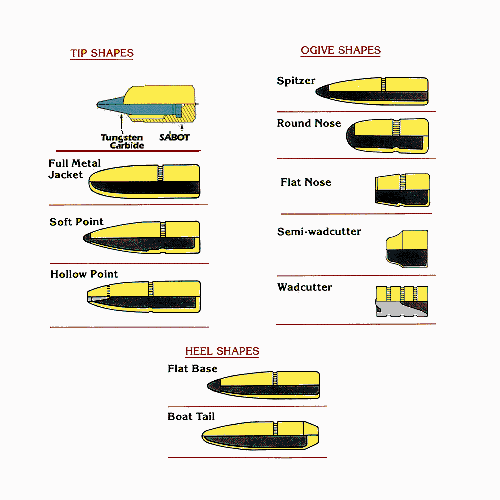
- Armor-piercing bullets contain a core of hardened steel.
- Ball usually contain a slug of antimony hardened lead except in case of the cal,
.50, wherein the outer core is of soft steel.
- Tracer contains a lead slug, and a chemical composition in the rear.
- Incendiary bullets contain an incendiary composition.
- Cartridge case: The cartridge case is the means whereby the other components are
assembled into the unit. It also provides a waterproof container for the propelling
charge.
Primer: Percussion
Propelling charge: The propelling charge consists of a quanity of smokeless powder. The weight of the charge is not constant. It is adjusted for each powder lot to give the required velocity with pressure within the limits prescribed for the weapon in which it is fired.




